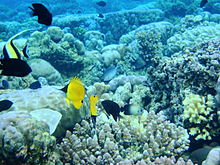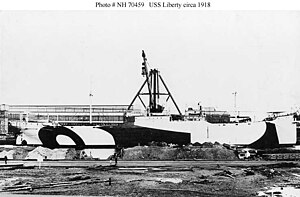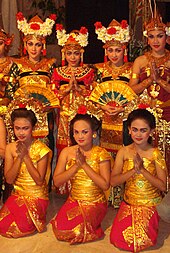Uploaded on Oct 8, 2009
Scuba diving at Bunaken Island near
Manado in Indonesia.
This is the best of the footage from my 2006 trip, including a baby whale shark at Lekuan.
This whale shark was only 4 or 5 feet long and had two big remoras attached to it.
More Bunaken Island and Manado SCUBA Diving videos at http://www.bubblevision.com/underwater-videos/Bunaken-Manado/
This is the best of the footage from my 2006 trip, including a baby whale shark at Lekuan.
This whale shark was only 4 or 5 feet long and had two big remoras attached to it.
More Bunaken Island and Manado SCUBA Diving videos at http://www.bubblevision.com/underwater-videos/Bunaken-Manado/
The park is located near the center of the Coral Triangle, providing habitat to 390 species of coral[2] as well as many fish, mollusc, reptile and marine mammal species.
The Park is representative of Indonesian tropical water ecosystems, consisting of sea-grass plain, coral reef, and coastal ecosystems.[3]
It was established as a national park in 1991 and is among the first of Indonesia's growing system of marine parks.
It covers a total area of 890.65 km², 97% of which is marine habitat.
The remaining 3% of the park is terrestrial, including the five islands of Bunaken, Manado Tua, Mantehage, Nain and Siladen.
The southern part of the Park covers part of the Tanjung Kelapa coast.[3]
Geology
North Sulawesi is considered to be a 'young' formation, of 5-24 million years of age.The region has undergone explosive volcanism 1.5-5 million years ago, which resulted in the volcanic tuff that characterizes the existing topography.
Manado Tua is an inactive volcano formed in a classical cone shape and rising over 600 m above sea level, the highest elevation in the park.
Bunaken Island also has volcanic origins with a significant amount of uplifted fossil coral.
Nain Island is also a dome-shaped island, 139m in height. Mantehage Island is relatively flat and seems to be sinking into the sea.
The island has extensive mangrove forest flats, partially separated by saltwater channels.
Siladen is a low-lying coral sand island with no significant topography.
Arakan-Wawontulap and Molas-Wori on the mainland of North Sulawesi are relatively flat areas at the base of volcanic hills.
The absence of a continental shelf allows the coastal area of the park to drop directly down the continental slope.
The sea depth between the islands of the park is 200 to 1,840 meters.[4]
| Bunaken National Park | |
|---|---|
IUCN category II (national park)
|
|
 Bunaken Island seen from Manado Tua island. |
|
| Location in Sulawesi | |
| Location | Sulawesi, Indonesia |
| Nearest city | Manado |
| Coordinates | 1°40′N 124°39′ECoordinates: 1°40′N 124°39′E |
| Area | 890 km² |
| Established | 1991 |
| Visitors | ca.35,000[1] (in 2003-06) |
| Governing body | Ministry of Forestry |
Flora and fauna
A very rich coral ecosystem covers most of Bunaken National Park, dominated by fringing reef and barrier reef corals.[3]
There are about 390 species of coral recorded in the waters of the Park.[2]
A distinct feature is a 25-50 meter vertical coral wall which is inhabited by 13 coral genus.
The seaweeds that can be found here include Caulerpa, Halimeda, and Padina species, while the dominant sea-grasses, in particular in the islands of Montehage and Nain, are Thalassia hemprichii, Enhallus acoroides, and Thalassodendron ciliatum.
The park is also abundant in different species of fish, marine mammals and reptiles, birds, molluscs and mangrove species.[3]
About 90 species of fish live in the waters of the park, among them being the Emperor Angelfish, Almaco Jack, Spotted Seahorse, Bluestripe Snapper, Pinkish Basslet and Two-lined monocle bream.
The species of mollusc include the Giant Clam, Horned Helmet Shells, Chambered Nautilus, and ascidians.[3]
It is claimed that this park has seven times more genera of coral than Hawaii[5], and more than 70% of all the known fish species of the Indo-Western Pacific.[6]
On land, the islands are rich in species of palm, sago, woka, silar and coconut.
Among the animal species that live on the land and the beaches are Celebes crested macaque, Timor Deer, and Sulawesi bear cuscus.
The mangrove forest of the Park contains, among others Rhizophora and Sonneratiaspecies.
This forest is also rich in species of crab, lobster, mollusc, and sea birds such as gulls, herons, sea doves, and storks.[3]
Human habitation and tourism
Most locals work as fishermen or farmers cultivating coconut, sweet potato, banana or seaweed for export, while a small number are employed in tourism as dive guides, boat operators and cottage staff.[7]
Tourism is strongly developed, with accommodation ranging from backpacker cottages to 5 star resorts.[1]
Between 2003 and 2006 the number of visitors ranged from 32,000 to 39,000 of which 8-10,000 were international visitors.[1]
Conservation and threats
Bunaken National Park was formally established in 1991 and is among the first of Indonesia's marine parks.In 2005 Indonesia submitted an application to UNESCO for including the park on the World Heritage List.[4]
Despite its national park status and significant funding, the park has suffered a slow, continuous degradation due to a number of threats including coral mining, anchor damage, blast fishing, cyanide fishing, diving, and trash.[1]
The World Wildlife Fund provides conservation support in the National Park as part of the Sulu Sulawesi Marine Eco-region Action Plan.
This includes participatory enforcement and patrol, which resulted in significant reduction of blast fishing.[8]
Source: Wikipedia.org
Somebody Come and Play in Traffic with Me! Earn as You Learn, Grow as You Go!
The Man Inside the Man
from
Sinbad the Sailor Man
A
JMK's Production
Share this page, If you liked It Pass it on, If you loved It Follow Me!
TTFN
CYA Later Taters!
Thanks for watching.
Donnie/ Sinbad the Sailor Man
Somebody Come and Play in "Traffic" with me. If you would like to "Join" A Growing Biz Op! Here is Your Chance to get in an Earn While You Learn to Do "The Thing" with us all here at Traffic Authority.
Simply click this link and Grow as you Go Come and Play In Traffic With Me and My Team at Traffic Authority!
Simply click this link and Grow as you Go Come and Play In Traffic With Me and My Team at Traffic Authority!
P.S. Everybody Needs Traffic! Get Top Tier North American Traffic Here!














